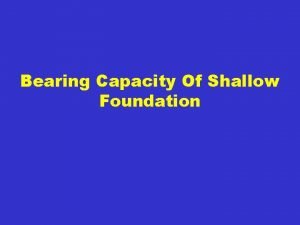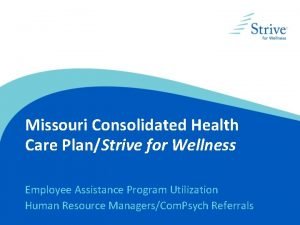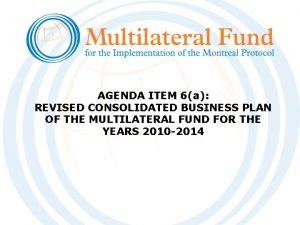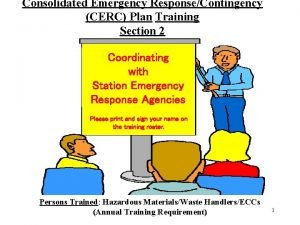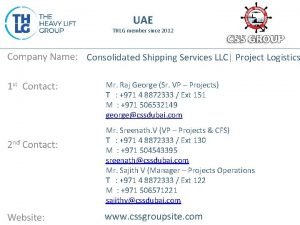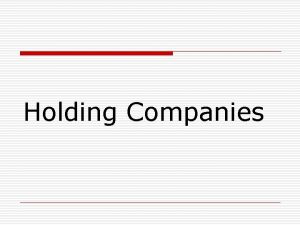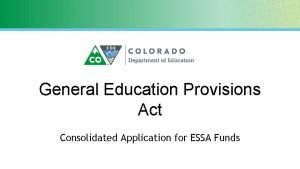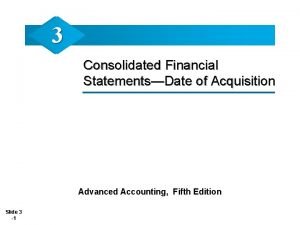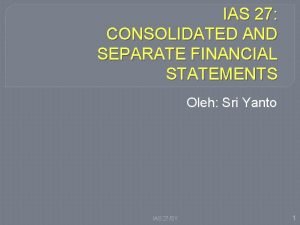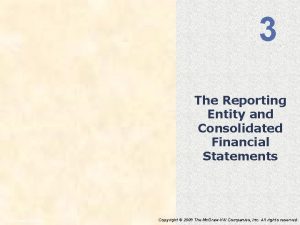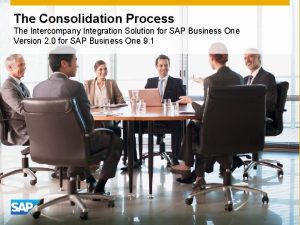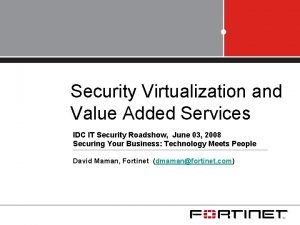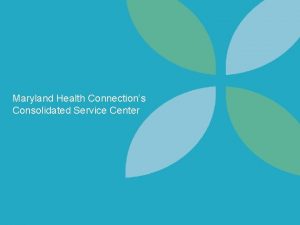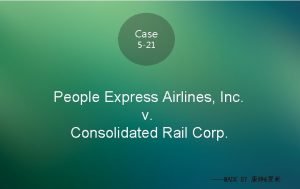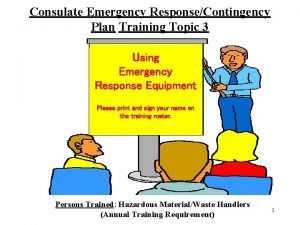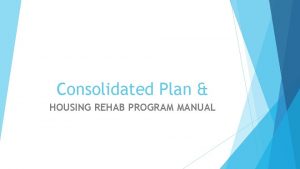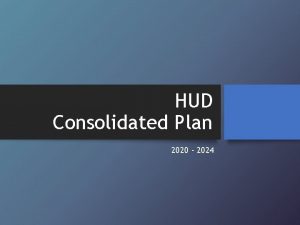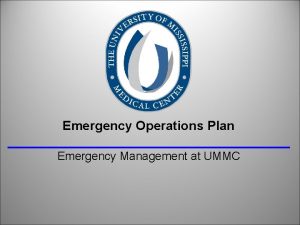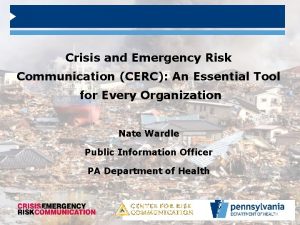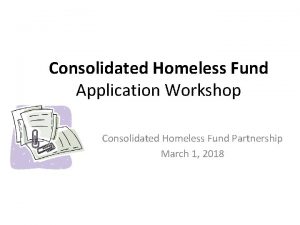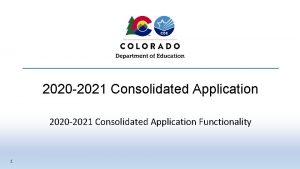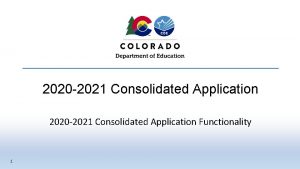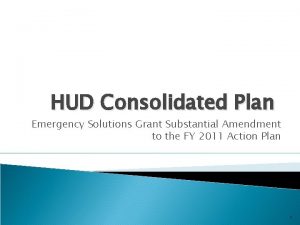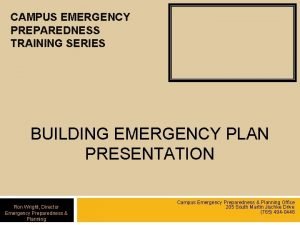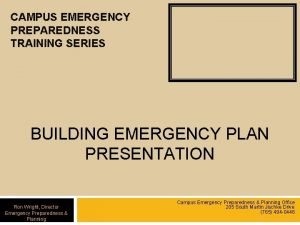Consolidated Emergency ResponseContingency CERC Plan Training Section 2















- Slides: 15

Consolidated Emergency Response/Contingency (CERC) Plan Training Section 2 Coordinating with Station Emergency Response Agencies Please print and sign your name on the training roster. Persons Trained: Hazardous Materials/Waste Handlers/ECCs (Annual Training Requirement) 1

LEARNING OJECTIVES • Terminal Objective: Meet the Consolidated Emergency Response/Contingency Plan annual training requirement for coordinating with emergency response agencies. • Enabling Objectives: – Define Emergency Response – Recognize Emergency Situations – Define Incidental Spills – Implement Emergency Notification Procedures 2

BACKGROUND • In cases of major spill events or major emergencies we must know how to conduct evacuation, get emergency medical, request response assistance to control or clean-up a spill, or otherwise neutralize a hazard. • Most accidental spills and leaks are minor and within our response capabilities. • For large spills, outside assistance may be required. 3

EMERGENCY SITUATIONS • Emergency situations may include: • …a fire, visible or noxious fumes, or other significant health and safety hazards. • …an off-site, or potential offsite impact such as the spill contaminating soil or entering storm drain. • …a need for assistance outside our unit to stop, contain, and/or clean up a chemical release. • Or if there is any doubt about the situations above. 4

EMERGENCY RESPONSE DEFINED 29 CFR 1910. 120(a)(3) • “…an occurrence which results, or that is likely to result, in an uncontrolled release of a hazardous substance…” • “Release” meaning a hazardous substance getting into the environment (air, waterway, soil). • “Uncontrolled” meaning that stopping, containing, or cleaning up the release is beyond our unit’s ability. 5

INCIDENTAL SPILLS (Non Emergency Response) • Minor, “incidental”, spills that happen from time to time: – No release to the environment and no one got hurt. – No significant safety or health hazard. – No outside assistance needed to control or clean-up. – No implementation of the emergency plan required. • Incidental spills can be avoided by following HM handling guidance in Contingency Plan Section 1. • Incidental spills must be cleaned up immediately and logged into the unit’s Spill Log. 6

SPILL PREVENTION, CONTROL, AND COUNTERMEASURES PLAN (SPCC Plan) • Established to prevent oil spills into U. S. waters and “sensitive” environments. – Storm drains and sanitary sewers. – Rose and Sycamore Canyons on MCAS Miramar. • SPCC Plan lists oil spill prevention structures, procedures, and equipment. – Secondary containment around tanks and HW sites. – Overfill alarms and emergency shut-off valves. – Spill equipment and response procedures. 7

SPCC PLAN(2 of 2) • SPCC Plan in its entirety is maintained by the Environmental Department. • Each unit affected by the Plan has their portion onhand must be familiar with its contents. • Our unit’s portion of the SPCC Plan is tabbed in our unit’s HW Compliance Binder, Volume I. Note: Not all units are affected by the SPCC Plan so you may not have a specific portion of the Plan. 8

Consolidated Emergency Response/Contingency Plan • Sections A - K: • Some items that will be covered include: * Emergency Response Plan w/Site Map * Employee Training Description * Emergency Equipment Inventory 9

EMERGENCY NOTIFICATION PROCEDURES • If the situation warrants emergency response, call 911 for fire, medical, and PMO assistance. • Be prepared to tell the 911 Dispatcher: – Your name and telephone number. – Exact location of the incident (bldg and room number, if applicable). – Description of what is happening. – Any other relevant information or conditions likely to 10 worsen situation.

EMERGENCY NOTIFICATION PROCEDURES (2 of 2) • Do not hang up the telephone until the 911 Dispatcher terminates the call. • Ranking person acts as On-Scene-Commander until relieved by the Miramar Fire Dept. • DO NOT call off-base agencies. The Miramar Fire or Environmental Department will contact off-base agencies, if required. • Complete spill report as required. 11

ON-SCENE-COMMANDER • Start or continue any required evacuation and crowd control. • Gather additional useful information w/o risking hazard exposure. • Be prepared to guide emergency response personnel and a provide situation update. • Have SDS’s on-hand to assist responders, if available. 12

SPILL CLEAN-UP • Clean-up usually will not start until after the emergency is under control and the emergency “all clear” sounded by MFD. • MFD or Environmental Dept determines if outside response or clean-up assistance is needed. • The responsible unit usually cleans up spills. Note: Call 911 if needed, then call Environmental Dept. at 577 -1108. 13

REVIEW • Emergency Response is required when the incident is beyond our capabilities, there’s a fire, or someone is seriously injured. • Call 911 (or pull the fire alarm) in case of emergency and provide the Dispatcher emergency information. • Be prepared to assist the responders when they arrive on the scene. • Notify on-station responders and departments only. • Complete spill report as required. • Units clean up incidental (minor) spills. • Sign-in on the Training Roster (CERC). 14

QUESTIONS? • Contact your unit’s Hazardous Waste Coordinator (HWC) or your Group’s Environmental Compliance Coordinator (ECC) for emergency assistance. • Unit and Group HWCs/ECCs should contact the Environmental Department’s Waste Management Division at 577 -1108 for questions regarding this presentation and/or for training assistance. 15
 Normally consolidated and over consolidated soil
Normally consolidated and over consolidated soil Missouri consolidated health care
Missouri consolidated health care Consolidated business plan
Consolidated business plan Cerc plan
Cerc plan Consolidated shipping services
Consolidated shipping services Sezhub
Sezhub Capital reserve meaning
Capital reserve meaning Gepa statement samples
Gepa statement samples Consolidated financial statements date of acquisition
Consolidated financial statements date of acquisition Ias 27
Ias 27 Advantages and disadvantages of vane shear test
Advantages and disadvantages of vane shear test Incomparent
Incomparent Consolidated companies are different sap
Consolidated companies are different sap Noc saga consolidated
Noc saga consolidated Consolidated service center
Consolidated service center People express airlines v consolidated rail corp
People express airlines v consolidated rail corp
